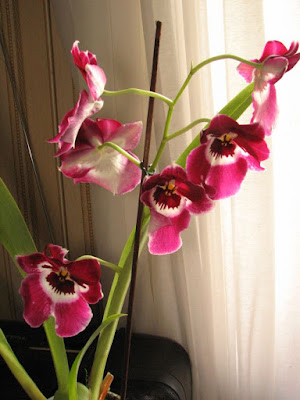Miltoniopsis Augres "Trinity" is a hybrid between Miltoniopsis Pam-Pam and Miltoniopsis Alger. This hybrid has been awarded the Royal Horticultural Society Award of Merit (AM / RHS).
Miltoniopsis Augres "Trinity" is a hybrid between Miltoniopsis Pam-Pam and Miltoniopsis Alger. This hybrid has been awarded the Royal Horticultural Society Award of Merit (AM / RHS).
IDENTIFY MILTONIOPSIS AUGRES TRINITY ORCHID HYBRID
This hybrid blooms in the period from April to August. Duration of flowering is about 8 weeks. The size of flowers is 8 cm in diameter. The total size of the plant is 40-50 cm in height.
After flowering, the peduncle is removed, if necessary, the orchid is transplanted and kept relatively dry for some time at a temperature not higher than 20 ° C. This is necessary to acclimatize the plant and to prevent wound rotting on the roots resulting from transplantation.
MILTONIOPSIS AUGRES TRINITY ORCHID HYBRID CARE AND CULTURE
Cultural information should only be used as a guide, and should be to be adapted to suit you. Your physical location; where you grow your plants, how much time you have to devote to their care, and many other factors, will need to be taken into account. Only then can you decide on the cultural methods that best suit you and your plants.
Light:
Miltoniopsis Augres "Trinity" refers to shade-loving orchids, so for its successful cultivation the intensity of illumination must be much lower than usual with orchids. Best of all, this hybrid feels on the eastern and relatively bright northern windows, or in the shade of other plants. With intense sun exposure, orchid leaves turn greenish-yellow to reddish in color.
Temperature:
This hybrid is considered the most tolerant in relation to high summer temperatures, so it can be grown in both moderate and warm temperatures. Day temperature at 20-28 ° C; Night temperature at 15-18 ° C; For the successful cultivation at home it is very important that the night temperature of the content is always 5 ° C lower than the daytime. The flowering of this hybrid depends on fluctuations between day and night temperatures.
Humidity:
The humidity level of 50-70% is considered an ideal indicator. Too dry air has a negative effect on the overall growth and development of the plant. The higher temperature, the higher the humidity should be, and the higher the humidity, the more often and longer it is necessary to ventilate the room where orchids are contained, otherwise the probability of rotting and leaves of various kinds of fungal diseases.
Substrate, growing media and repotting:
Miltoniopsis Augres "Trinity" is grown mainly in pots, therefore the substrate must be very breathable. The most recommended mixture: 60% of the bark of conifers, 20% peat, 15% foam, 5% quartz sand, 5 gr lime and 1 gr gypsum. Pots for planting need to choose small and narrow, since the root system of the plant is rather small and develops relatively slowly. If there is a lot of space in the pot, the substrate will slowly dry out and the root system may start to rot. In order for the orchid not to fall, it is recommended to use heavy clay pots.
It is recommended to replant this hybrid annually or at least once every two years. The best time for transplanting is the period immediately after flowering and until the moment when new young shoots begin to grow their own roots. Transplantation in the summer is highly undesirable, as at high temperatures the orchid can get severe stress and die. When transplanting into a new pot, you must carefully monitor that the shoots are not buried deep, otherwise water will constantly fall into the sinuses between the leaves, which will inevitably lead to their rotting.
Watering:
In the period from March to November, this hybrid needs frequent and abundant watering. The substrate between waterings should dry out relatively well, but not dry completely. This is especially important during the flowering period, since 100% over-drying of the substrate is fraught with drying out of the edges of flowers or their premature fading. In winter, watering orchids is somewhat reduced, and watering the orchid at this time is necessary only when the substrate dries out completely. Excess water during irrigation should flow freely from the pot, since stagnation of water both inside the pot and in its pan can very quickly lead to rotting of the roots and the lower part of the plant.
On hot sunny days when the air temperature rises above 25 ° C, spraying the outside of the plant is recommended. However, it is highly undesirable to spray the plant in the evening, since in the evening the water evaporates badly and the accumulation of water in the grooves between the leaves can very quickly lead to their decay.
Fertilizer:
During the period of new growth they fertilize this hybrid no more than once a month and a maximum of 1/2 (preferably 1/4) of concentration fertilizer indicated on the package. To prevent salinization of the substrate, it is strongly recommended that it is washed well every six months.
Rest period:
Miltoniopsis Augres "Trinity" does not need a rest period tp stimulate flowering, nor in winter. However, closer to the time of maturation of new shoots, i.e. when they reach the size of old pseudobulbs, it is strongly recommended that the total temperature of the content does not exceed 20-22 ° C. If it is impossible to achieve this at home, it is best to keep the plant outdoors in the summer: on the balcony or in the garden.















COMMENTS